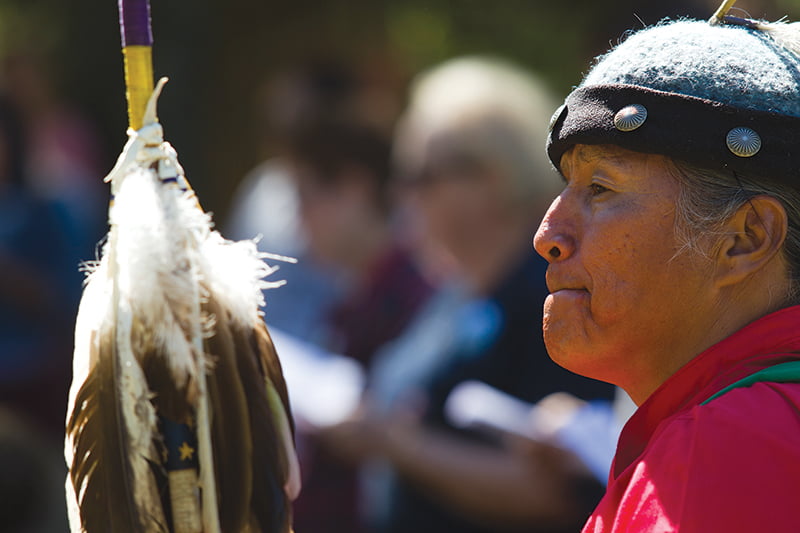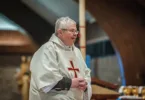
Stanley Perry, a Navajo from Arizona, brought his eagle staff on the march and used it for blessing plaques along the trail. LEAVEN PHOTO BY JAY SOLDNER
By Joe Bollig
joe.bollig@theleaven.org
MOUND CITY — When the Potawatomi Indians were forced to go to Kansas in 1838, their journey became known as the Trail of Death.
Now, 180 years later, a caravan of Potawatomi and others made the 660-mile journey to Kansas in commemoration of that terrible event.
On Sept. 22, a group of some 35 people gathered at the St. Rose Philippine Duchesne Memorial Park and Shrine, northwest of Mound City, for a Mass and dinner.
These marked the end of the pilgrimage, which began at the Chief Menominee Monument, south of Plymouth, Indiana, on Sept. 17.
The Mass was celebrated by Father Barry Clayton, pastor of St. Philip Neri Parish in Osawatomie, Sacred Heart Parish in Mound City, and Our Lady of Lourdes in LaCygne.
The pilgrims included Potawatomi, historians, women religious and others interested in the forced removal of the Potawatomi nation from its Great Lakes area homeland.
One of the six religious who took part was Sister Deanna Rose von Bargen, RSCJ, of Redwood City, California. She and five other Sisters who made the pilgrimage belong to the same order as St. Rose Philippine Duchesne, who ministered at the former Sugar Creek Mission to the Potawatomi.
Although they had a tight schedule, the pilgrims took time to stop at monuments and important sites along the way, said Sister Deanna. Interestingly, the weather they experienced mirrored that recorded in diary entries of the 1838 journey.







Is this the same as the Trail of Tears ? Seems like it was the same year , so sad .
This Potawatomi Trail of Death Commemorative Caravan, Sept. 17-22, 2018, began at Rochester, Indiana, and was the 7th caravan enacted every 5 years since 1988. It was organized by Fulton County Historian Shirley Willard. Every year the Fulton County Historical Society produces the Trail of Courage Living History Festival the 3rd weekend of Sept. to honor the Potawatomi and show life in Frontier Indiana with foods cooked over wood fires, 2 stages with period music & dance, canoe rides, historic camps and traditional crafts, games and more. Each year a different Potawatomi is honored with a key to the city. Northern Indiana was Potawatomi Territory until the terrible forced removal that became the Trail of Death. The Potawatomi were marched at gunpoint down Rochester’s Main Street Sept. 5, 1838. We wish it had never happened but you can’t change history – we need to remember it and learn from history.
Wonderful story! My ancestor was one of those on the original Trail of Death and my 92-year-old father, Robert Pearl, has gone on the Trail of Death Caravan seven times since 1988. Thank you for the coverage of our story in history. How do I receive a paper copy of the Leaven with the article in it?